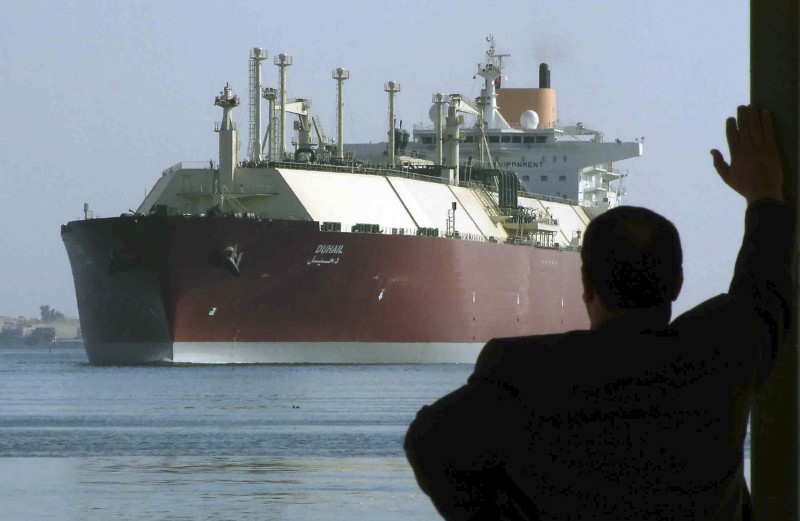By Henning Gloystein and Mark Tay
SINGAPORE (Reuters) - Qatar's plan to boost liquefied natural gas (LNG) output by 30 percent is the opening shot in a price war for customers in Asia pitting the Gulf state against competitors from the United States, Russia and Australia.
Qatar, facing regional isolation in a diplomatic dispute with its Gulf neighbours, took energy markets by surprise on Tuesday when it said it would raise its LNG production to 100 million tonnes per year - equivalent to a third of current global supplies - within the next five to seven years.
It suggests the wealthy kingdom is preparing for a lengthy battle with Saudi Arabia, Egypt, the United Arab Emirates and Bahrain, who were due to meet on Wednesday to decide whether to continue sanctions they imposed on Qatar over accusations it was aiding terrorism and courting regional rival Iran.
Qatar's move will add gas to an already oversupplied market in a thinly disguised challenge to other exporters who are also raising their output.
With low production costs and infrastructure already in place, Qatar is well placed to come out on top, analysts say. Flooding the market with more LNG will help defend its place as the world's top exporter, a position challenged by Australia.
"Qatar is losing market share, so it could be about becoming number one again in LNG," said Neil Beveridge, senior oil and gas analyst at research and brokerage firm Sanford C. Bernstein.
FOCUS ON ASIA
LNG is super-cooled natural gas that is transported on tankers around the world.
Long a niche product, it has become an industry darling as natural gas is a cleaner fossil fuel than oil or coal and is also versatile, with potential uses ranging from power generation to heating and as a transport fuel.
U.S. and European oil majors such as Royal Dutch Shell (LON:RDSa) and Chevron (NYSE:CVX) have invested huge sums over the last decade - often more than they have spent on oil - in an attempt to dominate the LNG market, especially through mega-projects in Australia such as Chevron's Gorgon or Shell's Prelude.
The main battleground for LNG market share is Asia, which consumes 70 percent of the fuel and where it is seen as a key fuel to meet soaring energy demand without the rampant pollution that comes with coal.
The world's biggest LNG buyers are utilities, especially from Japan and South Korea.
Sources at these utilities said they were surprised by Qatar's move.
"We would have to figure out why Qatar is planning to boost its output.. We don't have plans yet to import new LNG cargoes from Qatar," said Kim Young-ki, a spokesman at Korea Gas Corp. (KOGAS), one of the world's biggest single LNG buyers.
RAMPING UP PRODUCTION
Qatar's announcement came just a day after Iran signed its first deal with France's Total and China's state-owned oil company CNPC to produce gas from a field it shares with Qatar.
Beveridge, at Sanford C. Bernstein, said Qatar's move to raise output "could be a response to Total restarting development work" on Iran's side of the gas reserves.
Trying to cement its own market share, Russia's Gazprom (MCX:GAZP) the world's biggest single producer of natural gas, said late on Tuesday that it would start pumping gas to China through a new pipeline by late 2019, earlier than many expected.
China is already the top consumer of most commodities, including oil and coal, and as part of a huge investment programme to expand its LNG and pipeline infrastructure it is also on its way to become a top natural gas user.
Australia has invested hundreds of billions of dollars in a bid to overtake Qatar as the world's top LNG exporter by 2019, a challenge Qatar is now rising to.
Qatar, whose state-owned Qatar Petroleum has partnered with U.S. oil giant Exxon Mobil (NYSE:XOM) to produce its LNG, has a strong interest in defending its position.
LNG, as well as exports of condensate, a super-light form of crude oil that's a byproduct of gas extraction, have made Qatar rich despite a 70 percent fall in LNG prices and a more than 50 percent drop in oil prices since 2014.
Ramping up LNG exports to 100 million tonnes a year would, at current prices, reap revenues of around $30 billion, with another $6 billion coming from condensate.
That equates to $120,000 per person, helping Qatar to become the world's richest nation, according to the World Bank.
STIFF COMPETITION
The main producers challenged by Qatar's move are those who have yet to attract a final investment decision, especially in the United States.
So far only Cheniere exports U.S. LNG, but there are proposals with a total capacity of 150 million tonnes per year.
Chong Zhi Xin, at energy consultancy Wood Mackenzie, said Qatar's low cost LNG expansion "is pushing a lot of new projects out of the market".
Flooding the market with more LNG at a time of oversupply and when buyers are reluctant to sign on new long-term contracts – which have so far dominated supplies – is expected to boost trading in Asia's spot LNG market, which currently makes up just 15 percent of overall supplies, as more uncontracted supply gets exchanged according to short-term demand.
The winners in this aggressive fight for market share are consumers.
"Expansion of LNG capacity translates to lower for longer LNG prices," said Kerry Anne Shanks, head of Asia gas and LNG research at Wood Mackenzie. "That's good news for gas buyers."

(For a interactive Qatar graphic, click http://tmsnrt.rs/2sUeuas)